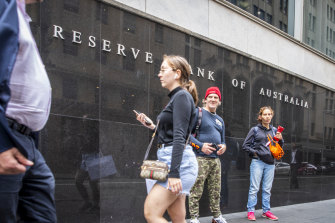RBA holds rates starts winding back economic support
The Reserve Bank has started winding back the support it has used to prop up the Australian economy through the coronavirus recession, axing its policy to target the price of a key government bond.
Following its regular monthly meeting on Tuesday, the RBA board left the official cash rate at 0.1 per cent and announced it would maintain its policy of buying $4 billion in government bonds a week until mid-February.

The RBA board left the official cash rate at 0.1 per cent.Credit:Louie Douvis
But in a sign of the economy’s improvement, bank governor Philip Lowe said the policy of targeting the yield on the three-year Australian government bond to stay at 0.1 per cent would end.
“The decision to discontinue the yield target reflects the improvement in the economy and the earlier than expected progress towards the inflation target,†he said.
“Given that other market interest rates have moved in response to the increased likelihood of higher inflation and lower unemployment, the effectiveness of the yield target in holding down the general structure of interest rates in Australia has diminished.â€
The move comes after the bank delivered an unprecedented level of financial support over the past two years.
It started cutting interest rates in reaction to the coronavirus pandemic in March last year when it took the cash rate to 0.5 per cent. A fortnight later, it cut rates to 0.25 per cent while announcing its plan to target the three-year Australian government bond rate. It also started offering $90 billion in cheap cash to the nation’s banks so they could on-lend that to small and medium-sized businesses.
Eight months later at its November meeting, it cut the cash rate to 0.1 per cent and reduced its target for the three-year Australian government bond rate to 0.1 per cent. It also announced plans to start buying $100 billion in federal, state and territory government bonds.
At the time, the bank believed it would need to keep the cash rate at 0.1 per cent until at least 2024. It has stuck by that position following every board meeting this year.
But last week, after inflation data showed underlying price pressures at their highest levels in six years, the bank decided against trying to keep the three-year bond rate at 0.1 per cent. It has now reached 0.7 per cent, the level it was before the advent of the pandemic.
The official line that a rate rise would not occur until 2024 was missing from Dr Lowe’s statement on Tuesday.
Instead, he said the bank was prepared to be “patient†as it waited for wages and inflation to lift.
“The board will not increase the cash rate until actual inflation is sustainably within the 2 to 3 per cent target range. This will require the labour market to be tight enough to generate wages growth that is materially higher than it is currently. This is likely to take some time,†he said.
“The board is prepared to be patient, with the central forecast being for underlying inflation to be no higher than 2.5 per cent at the end of 2023 and for only a gradual increase in wages growth.â€
‘The board is prepared to be patient.’
RBA governor Philip LoweLast week’s higher than expected underlying inflation figures prompted markets to price in interest rate rises from next April.
But Dr Lowe played down the figures.
“Inflation has picked up, but in underlying terms is still low, at 2.1 per cent. The headline CPI inflation rate is 3 per cent and is being affected by higher petrol prices, higher prices for newly constructed homes and the disruptions in global supply chains,†he said.
“A further, but only gradual, pick-up in underlying inflation is expected.
“The central forecast is for underlying inflation of around 2.25 per cent over 2021 and 2022 and 2.5 per cent over 2023. Wages growth is expected to pick up gradually as the labour market tightens, with the wage price index forecast to increase by 2.5 per cent over 2022 and 3 per cent over 2023.
“The main uncertainties relate to the persistence of the current disruptions to global supply chains and the behaviour of wages at the lowest unemployment rate in decades.â€
Apart from the lift in inflation, there is also growing unease about the impact of low interest rates on the housing market.
Data from the Australian Bureau of Statistics this week showed first-home buyers and owner-occupiers being pushed out of the property market, replaced by investors.
Loans to investors climbed 1.4 per cent in September to be 83 per cent up over the past year â€" its highest level since mid-2015. But loans taken by first time buyers fell again to be 27 per cent down on their January peak.
Financial incentives and record low interest rates have helped Australians take on extraordinary levels of debt.
The average mortgage in NSW for an existing dwelling hit a record-high of $772,000 in September, an increase of almost $140,000 over the past 12 months. In Victoria, the average mortgage is now a record $637,000, a lift of $122,000 since September last year.
Shane Wright â€" Shane is a senior economics correspondent for The Age and The Sydney Morning Herald.Connect via Twitter or email.